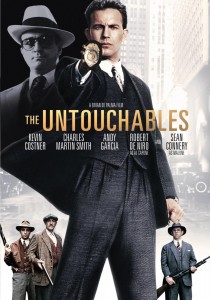 What do you get when you take a hokey old TV show about the nation’s most lawless law enforcers, and stretch it to about two hours even? That’s the Jeopardy! Version of a one line review of this movie.
What do you get when you take a hokey old TV show about the nation’s most lawless law enforcers, and stretch it to about two hours even? That’s the Jeopardy! Version of a one line review of this movie.
The Untouchables is a 1987 Brian de Palma film so you know it’s going to be soaked in cartooney violence — de Palma doesn’t disappoint (or maybe the correct term is, “doesn’t surprise”) on that expectation. It’s based on the 1959-63 Robert Stack cop show, which is based in turn on the posthumously-published memoir of Elliott Ness, a founding agent of the Prohibition Bureau, the agency that would become today’s ATF. Ness’s book, which we’ve never read (we just ordered a copy to rectify that error) was largely ghostwritten by sportswriter Oscar Fraley, and it launched Fraley on a new career of ghosting G-man tales, including at least one more by a member of Ness’s 11-man core “Untouchables” group.
The real Treasury agents got that nickname because, unlike Chicago’s local law enforcement (then, or now), they didn’t take bribes and cooperate with organized crime. Instead, they publicized and shamed bribe attempts. (This is shown in one scene in the movie, a scene that, once it gets started, is taut and on point).
The score deserves mention, because it doesn’t work. It’s by Ennio Morricone (of The Good, the Bad, and The Ugly fame). He’d lost the art of using the musical “rest” and, unfortunately, discovered the drum machine. It’s the Ugly, the Ugly, and the Ugly.
A Press Conference scene reminds us the only ones that Hollywood treats worse than the military, oddly enough, are reporters. But even though reporters as a pack are depicted as shallow and stupid, as individuals, they’re one of the phony city’s favorite hero types, and yes, there’s a Jimmy Olsen, Cub Reporter type – neither the part nor the performance rises above type – who’s the comic relief, sidekick type.
The blood-drenched movie ends with emo Ness shaking his head and intoning, “So much violence,” in a display of Hollywood hypocrisy right up there with any of them.
We just have to mention the Morricone score again, because throughout the movie it was utterly jarring, dreadful and distracting. It won a bunch of awards, but then, 1987 was in the midst of a cocaine epidemic, and that stuff’s supposed to be bad for your hearing.
Acting and Production
The big-name actors in the movie deliver big-name performances. Three in particular stand out.
Kevin Costner as Elliot Ness plays a sort of modern, anguished, vulnerable hero. ATF agents who celebrate the legend of the TV Ness will freak at the very idea of emo Ness. But if you’re going to have an emo Ness, the very underrated and expressive Costner is a good guy to play him.
Robert De Niro excels himself as Al Capone. Opening scene – over the top. Camera in ceiling as the mobster gets shaved and manicured. Later, he has a great reverse “save the cat” scene where he beats one of his underlings to death with a baseball bat.
Sean Connery has an Oscar-winning supporting role as an Irish cop, Jim Malone, who’s Yoda to Costner’s emo Luke Skywalker (Connery’s was the film’s only gold statuette).
He does have a pretty good line. When Ness tells him he’s a Treasury officer, Malone turns and walks away. “You just turned your back on an armed man!” Ness fumes.
Malone: “But you’re a Treasury officer.”
Ness: “But I just told you, I didn’t show you my badge.”
Malone: “But you said you’re a Treasury officer. Who would claim that who was not?”
A great deal of money was spent on this period drama, and it shows.
Accuracy and Weapons
This version of Ness carries an unlikely 1911. (The real Ness carried a .38 Colt Detective Special, once that model was introduced in 1927. The Detective Special is nothing but a Police Positive with a 2″ barrel). The cops are armed with revolvers, tommy guns, and pump shotguns (about right for the 1930s).
Along with the movie-only 1911 (they actually used Stars as substitutes in firing scenes, as they’re easier to make feed with blanks, and Colts in the non-firing scenes), Ness also picks up and uses a Colt Official Police revolver and uses it to chase Frank Nitti in the climactic foot chase. The actual movie Colt was later sold off, and can be seen on a prop-collectors’ website.
As you can see, it’s a post-1950 colt (the ramp on the front sight, and the squared-off grip frame, are giveaways). Apart from such subtleties, the good guys have period-correct (mostly, as some of the Colts are post-1950) revolvers, lever-actions (Winchester 94s) and pump shotguns (Winchester 97s and 12s).
The criminals are armed with similar stuff, including too many 1911s. They are 1980s-armed crooks in a 1930s movie! Frank Nitti, for instance, has a gaudy nickel 1911 (which is a Star Model B, actually. You can see the extractor in shots showing the gun’s right side). The real Frank Nitti was partial to .32 revolvers. But then again, the real Frank Nitti was 5’4″, closing in on middle age, and plump; the movie Nitti is taller, lean and young. Hollywood magic!
Everybody has a few Thompsons. They all have drum mags (the first was common for the era, as both cops and criminals used this gun. The second was not, entirely; drum vs. stick mags appear to have been about 50/50 in both police and criminal use).
While there was a lot of gunplay in Prohibition Chicago, it was mostly crook-on-crook; despite the body counts racked up by the TV Ness (Bob Stack, himself a champion sports shooter) and this movie version (Costner), the real Elliot Ness never shot anybody, although he did fire warning shots, and was not above pistol-whipping a gangster. Most of the real Untouchables also carried small Colts; one, Barney Cloonan, carried a .45 ACP Smith & Wesson M1917 revolver. Cloonan was a WWI vet Marine, and he was not the only war vet on the squad.
One real-world Ness weapon makes an appearance in a Hollywoodized version: his specialized raid truck, reinforced for ramming through doors and walls, and equipped with ladders to land agents on the roof. The empty-cask raid appears to have been a Hollywood creation; the real Ness hit paydirt with his first raid and kept the raids coming, although sometimes the crooks got away, leaving only the booze and stills or breweries. (That’s why he created the raid truck).
The movie Untouchables are distilled down to four characters. There’s no scope for the range of the real men: some selected for athleticism, some selected for their ability to blend in anywhere, and bringing varied expertise in everything from the new discipline of tailing-by-car to the old standby of undercover operations. It’s true that Ness wanted single men, because he expected casualties. The canny Capone refused to play that; as one of the other Untouchables remembered in his old age, “he knew that if he killed one of us, he’d be replaced by two more guys, and probably tougher ones.”
Apart from the story, a lot of care was taken with period details. When the agents fly off to hit a booze shipment, they fly in a period-correct Ford Trimotor. There are a lot of authentic-looking 1930s vehicles in here, something that fills producers with dread (will they work when we need them?).
The depiction of Chicago of the 1930s—which could be Chicago today – shows what happens when an underground is fully embedded in society. Al Capone owned Chicago Aldermen, Chicago judges, most of the Chicago Police Department, and the Chicago mayor. So in this case, it was a criminal underground, but some of the stories we read of occupied and totalitarian nations (especially the ones where resistance movements were successful) had a similarly pervasive underground. The techniques work the same way, regardless of whether you’re on the side of God or Devil.
The death of Frank Nitti is not only historically wrong, but almost incredibly, and not-almost laughably (as in completely, absolutely laughably) fake. The movie’s Nitti character is younger than de Niro’s Capone, reversing their original ages; and instead of meeting his end at the hands of incorruptible lawmen, a middle-aged Nitti drank himself into a stupor and then shot himself twice in the head with a Colt .32 revolver. But the death scene in the movie is not only completely different, but also ridiculously phony. If you can’t make special effects convincing, please, directors: kill the guy off camera.
The bottom line
Bottom line: too much money spent on a TV show, despite the stellar cast, some great moments (the script was by David Mamet, so there’s some brilliant dialogue), and enough violence to please Al Capone his ownself. This might have been a stronger movie if they didn’t use the names of historical figures and create a false impression of the movie being a true story.
If you do like a classic gangster film made with modern production values, check out our review of 2012’s Gangster Squad with Jeff Brolin, a similar romp that does violence to history but at least entertains a viewer.
For more information
These sites relate to this particular film.
- Amazon.com DVD page:
http://www.amazon.com/Untouchables-Kevin-Costner/dp/B00AEBB9NM/
- IMDB page:
http://www.imdb.com/title/tt0094226/
- IMFDB page:
http://www.imfdb.org/wiki/Untouchables,_The_(1987)
- Rotten Tomatoes review aggregator:
http://www.rottentomatoes.com/m/untouchables/
- Wikipedia page:

Kevin was a former Special Forces weapons man (MOS 18B, before the 18 series, 11B with Skill Qualification Indicator of S). His focus was on weapons: their history, effects and employment. He started WeaponsMan.com in 2011 and operated it until he passed away in 2017. His work is being preserved here at the request of his family.

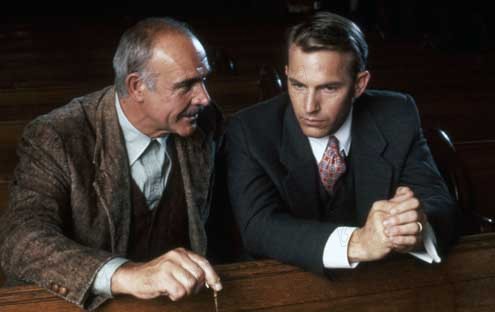
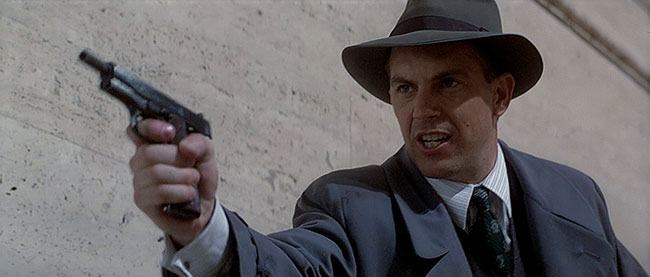
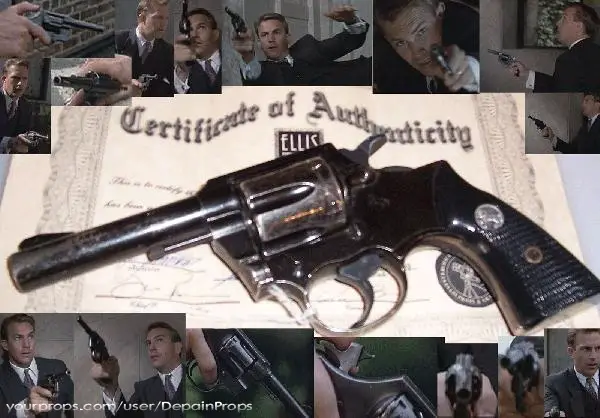
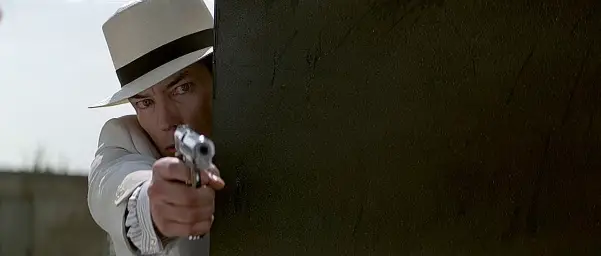
One thought on “Saturday Matinee 2014 13: The Untouchables (1987)”
Connery was magic in this film, including the obligatory Mercutioesque epic death scene.
But Oscar came to him as much in belated recognition of nearly 30 years’ unrewarded performances as much as for his work in Untouchables.
DeNiro is DeNiro. He already had his Oscar, and like Connery, he could read thoothpaste tubes and sell theatre tickets.
And even DePalma isn’t the bumbler many of his films would have you believe.
(I mean this not quite in the same way Twain said “Wagner’s music is better than it sounds.”)
Sometime, uneartch a copy of DePalma’s Blowout.
A lot of people thought John Travolta couldn’t act until they saw him in Pulp Fiction. but the truth is he showed his skills in Blowout thirteen years earlier.